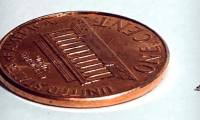
The 3D printed animal robot can move through the blood vessel, carry the drug nanoparticle and automatically eject it when it reaches its destination.

A team of researchers has found a very promising way, seemingly only needing tiny robots with special functions to bring life to cancer patients.

Weighing just a bit heavier than toothpicks, engineers at the University of Washington (USA) have created a new breakthrough in making tiny robots.

Scientists at the Massachusetts Institute of Technology have just developed a new type of robot capable of supporting screening for skin diseases, including skin cancer.

The Saltp-1P was first developed by the researchers in December, but in the latest version, the robot was equipped with small pushrods that could move side by side.

Simulating the behavior of insects in nature, Harvard's micro-robots are considered to be extremely effective spy, search, and rescue.
 The 3D printed animal robot can move through the blood vessel, carry the drug nanoparticle and automatically eject it when it reaches its destination.
The 3D printed animal robot can move through the blood vessel, carry the drug nanoparticle and automatically eject it when it reaches its destination. A team of researchers has found a very promising way, seemingly only needing tiny robots with special functions to bring life to cancer patients.
A team of researchers has found a very promising way, seemingly only needing tiny robots with special functions to bring life to cancer patients. Weighing just a bit heavier than toothpicks, engineers at the University of Washington (USA) have created a new breakthrough in making tiny robots.
Weighing just a bit heavier than toothpicks, engineers at the University of Washington (USA) have created a new breakthrough in making tiny robots. Scientists at the Massachusetts Institute of Technology have just developed a new type of robot capable of supporting screening for skin diseases, including skin cancer.
Scientists at the Massachusetts Institute of Technology have just developed a new type of robot capable of supporting screening for skin diseases, including skin cancer. The Saltp-1P was first developed by the researchers in December, but in the latest version, the robot was equipped with small pushrods that could move side by side.
The Saltp-1P was first developed by the researchers in December, but in the latest version, the robot was equipped with small pushrods that could move side by side. Simulating the behavior of insects in nature, Harvard's micro-robots are considered to be extremely effective spy, search, and rescue.
Simulating the behavior of insects in nature, Harvard's micro-robots are considered to be extremely effective spy, search, and rescue.





 Why did the ancient Babylonian civilization perish? Was it because they considered 'that thing' a daily meal?
Why did the ancient Babylonian civilization perish? Was it because they considered 'that thing' a daily meal? Just discovered a 72km 'tear in the Earth', the world's second largest country is in fear of a tsunami attack
Just discovered a 72km 'tear in the Earth', the world's second largest country is in fear of a tsunami attack Top 7 facts about the hottest place in the world, where you can fry eggs at outdoor temperature
Top 7 facts about the hottest place in the world, where you can fry eggs at outdoor temperature The Qing Dynasty collapsed, what surname did 20,000 royal descendants change to to integrate into the new era?
The Qing Dynasty collapsed, what surname did 20,000 royal descendants change to to integrate into the new era? After 389 days in the Arctic, costing more than $160 million, hundreds of scientists brought back bad news: What was it?
After 389 days in the Arctic, costing more than $160 million, hundreds of scientists brought back bad news: What was it? How long does it take to fall in love with someone?
How long does it take to fall in love with someone? How much silver has ever been discovered in the world?
How much silver has ever been discovered in the world? How does an atomic bomb work?
How does an atomic bomb work?